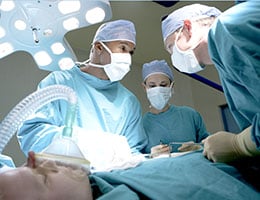 [6 MIN READ]
[6 MIN READ]
The Joint Commission (TJC) defines a Sentinel Event as “a patient safety event (not primarily related to the natural course of the patient’s illness or underlying condition) that reaches a patient and results in any of the following: death, permanent harm, or severe temporary harm and intervention required to sustain life.” TJC adopted a Sentinel Event Policy in 1996 in an effort to assist hospitals in voluntarily reporting, evaluating and reducing risk, and preventing patient harm. The term “never event” was first described in 2001 by Dr. Kenneth Kizer of The National Quality Forum (NQF) in reference to significant adverse medical errors that should never have taken place. The NQF currently uses this term when referring to serious reportable events deemed preventable. Whatever you choose to call these, they are simply events that really should not happen.
TJC recently released Sentinel Event statistics for 2018. This report1 lists the top 10 most frequently reported Sentinel Events. Falls and unintended retention of a foreign body (n= 111, 14% each) were tied for first; wrong-site surgery was third (n= 94, 12%). Many reports consider wrong-site surgery, wrong-side surgery and wrong-patient surgery separately; this can be useful in performing a root cause analysis and developing and instituting solutions.
The Indiana Medical Error Reporting System2 encompassing 894,995 hospital procedures and voluntary reporting of events found that surgery on the wrong body part was reported in 2.01 per 100,000 procedures and the wrong surgical procedure was reported in 0.67 per 100,000 procedures.
The question is, “Why do these things happen?” And perhaps just as importantly, “Why do they keep happening despite the acknowledgment that they should never occur?” The simple answer is that doctors, nurses and other healthcare workers are human, and humans make mistakes. The solution is to devise, implement and enforce system-based processes to avoid human error. There are moral, legal and financial imperatives to do so.
A review of 9,744 paid malpractice claims with surgical never events reported to the National Practitioner Data Bank (NPDB) reviewed by Mehtsun and associates3 showed that the most common event was retained foreign body (n=4857, 49.8%), followed by wrong-procedure (n=2447, 25.1%), wrong-site surgery (n=2413, 24.8%), and wrong-patient surgery (n=27, 0.3%). This study found that wrong-procedure surgery was associated with a 13.9% mortality, a 55.0% permanent injury rate, and a mean liability payment of $232,035. Wrong-site surgery was accompanied by a 2.7% mortality, a 41.5% permanent injury rate, and a mean liability payment of $127,159. Wrong-patient surgery had a 7.7% mortality, a 26.9% permanent injury rate, and a mean liability payment of $109,648. There are system processes that can reduce this unacceptable human cost and financial burden.
A Universal Protocol was described by TJC in 2003; it remains a foundation for preventing surgical errors. This three-step process includes: (1) conducting a pre-procedure verification process to confirm the correct patient, the correct procedure and the correct site; (2) marking the procedure site prior to surgery; and (3) conducting a time-out before starting the procedure to confirm both (1) and (2). In a review of 1,153 malpractice claims and 259 loss observations related to surgical care, Kwaan et al.4 identified 40 cases of wrong-site surgery, of which 25 cases (62%) were non-spine wrong-site procedures. The incidence rate for non-spine wrong-site surgery was 1 in 112,994 (0.885 per 100,000 procedures). Although the authors supported the Universal Protocol, they found that site verification protocols would not have prevented at least one-third of wrong-site surgery.
 The underlying root cause of wrong-site, wrong-side, wrong-patient surgery will vary, but careful analysis discloses overarching factors that are often involved. In a report of 294 surgical malpractice claims from the Netherlands, de Vries and co-authors5 found that 69% of preoperative contributing factors and 15% of perioperative factors correlated to an item on a pre-existing Surgical Patient Safety System (SURPASS) checklist. Of all incidents that led to permanent disability or death, the authors concluded that 30% might have been prevented had the SURPASS checklist been used. Improved adherence to system-based processes by all healthcare workers can improve patient safety, reduce adverse events and decrease liability.
The underlying root cause of wrong-site, wrong-side, wrong-patient surgery will vary, but careful analysis discloses overarching factors that are often involved. In a report of 294 surgical malpractice claims from the Netherlands, de Vries and co-authors5 found that 69% of preoperative contributing factors and 15% of perioperative factors correlated to an item on a pre-existing Surgical Patient Safety System (SURPASS) checklist. Of all incidents that led to permanent disability or death, the authors concluded that 30% might have been prevented had the SURPASS checklist been used. Improved adherence to system-based processes by all healthcare workers can improve patient safety, reduce adverse events and decrease liability.
A March 2019 report by the Minnesota Department of Health6 reviewed adverse health events, which are mandated to be reported from hospitals and ambulatory surgical centers licensed by the Minnesota Department of Health. The report shows a steady increase in the number of adverse events from 2014 (n=308) to 2018 (n=384). In 2018, the most common surgical/invasive procedure event was retained foreign object (n= 33), followed by wrong-site surgery (n=24) and wrong-procedure (n=22). In wrong-site surgery cases where procedure site marking was required, no preoperative marking was done 20% of the time, the team failed to visually confirm the site mark 20% of the time, and the team did not refer to source documents to verify the procedure and site 12% of the time. In a report from the United Kingdom based on surgeon self-reporting, Bathla and associates7 found that only 36.1% routinely marked all of their patients preoperatively. When marking was actually done, the surgeon marked the site in 69% of cases, and delegated this task to a junior doctor or nurse practitioner in 31%. Importantly, even in cases where site marking was done, only 55.6% were visible after draping.
The implications are clear. Although human error is expected, system processes can be developed, implemented, and enforced to reduce wrong-site, wrong-side, and wrong-patient surgery. However, such processes will not help if they are not routinely followed. Standardized system-wide policies and procedures should be established and followed. A culture of patient safety should be encouraged, wherein all members of the healthcare team take ownership of the processes and are empowered to speak out and identify any deviation from accepted protocols. These system processes should address multiple factors prior to the initiation of the operative procedure.
Prior to the procedure:
- The patient, the procedure and the site must be verified. The patient should be involved in this process whenever possible.
- All information and documentation required for the procedure should be available.
- The surgical site should be marked immediately prior to the procedure, ideally by the responsible surgeon who will be present during the procedure; the surgeon should use a standardized marking device in a standardized manner. The mark should be sufficiently permanent to be easily visible after prepping and draping. If possible, the patient should participate in this process by confirming the correct site.
- Finally, a dedicated time-out should be conducted involving all members of the surgical team simultaneously.
Multiple members of the team should confirm all of the above information and identify that all necessary equipment, documentation and personnel are available; only then should the procedure begin. Once incorporated into the pre-procedure routine, these critical steps take little additional time; there is rarely, if ever, a valid reason for omitting any of them.
Stress and emotions can and do run high in the operating room, but it is the responsibility of every member of the surgical team to follow – and compel others to follow – protocols designed and adopted to reduce surgical errors and improve patient safety.
References
[1] The Joint Commission Online. March 13, 2019. Available at: https://www.jointcommission.org/assets/1/23/JC_Online_March_13.pdf (last accessed April 3, 2019).
[2] Indiana State Department of Health Indiana Medical Reporting System Final Report for 2015. Available at: https://www.in.gov/isdh/ (last accessed April 3, 2019).
[3] Mehtsun WT, Ibrahim AM, Diener-West M, Pronovost PJ, and Makary MA. Surgical never events in the United States. Surgery. 2013;153:465-72.
[4] Kwaan MR, Studdert DM, Zinner MJ, and Gawande AA. Incidence, Patterns, and Prevention of Wrong-Site Surgery. Arch Surg. 2006;141:353-358.
[5] de Vries EN, Eikens-Jansen MPHamersma AM, Smorenburg SM, Gouma DJ, and Boermeester MA. Prevention of Surgical Malpractice Claims by Use of a Surgical Safety Checklist. Ann Surg. 2011;253:624–628.
[6] Adverse Health Events in Minnesota 15th Annual Public Report. Annual Report March 2019. Available at: https://www.health.state.mn.us/facilities/patientsafety/adverseevents/docs/2019ahereport.pdf (Last accessed April 4, 2019).
[7] Bathla S, Chadwick M, Nevins EJ , and Seward J. Preoperative Site Marking: Are We Adhering to Good Surgical Practice? J Patient Saf. 2017;00: 00–00.


